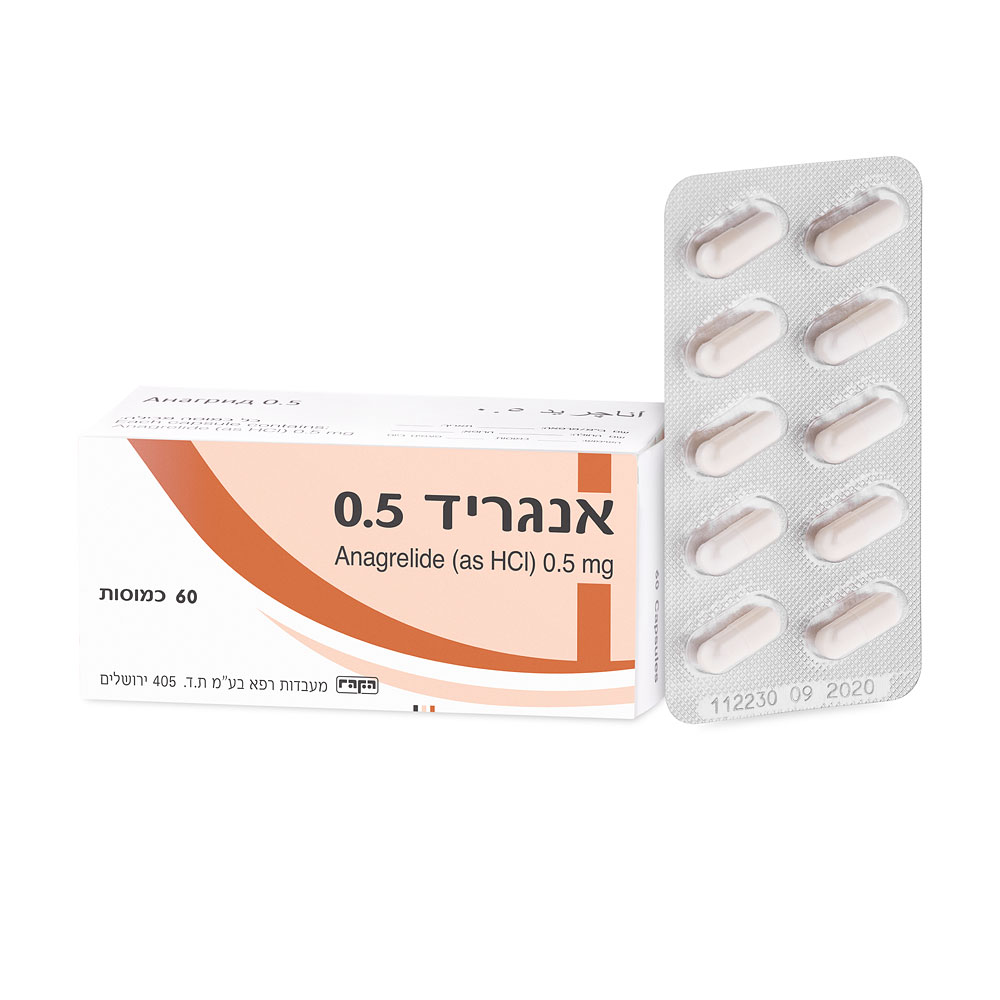Quest for the right Drug

אנגריד 0.5 ANAGRID 0.5 (ANAGRELIDE AS HYDROCHLORIDE)
תרופה במרשם
תרופה בסל
נרקוטיקה
ציטוטוקסיקה
צורת מתן:
פומי : PER OS
צורת מינון:
קפסולות : CAPSULES
עלון לרופא
מינוניםPosology התוויות
Indications תופעות לוואי
Adverse reactions התוויות נגד
Contraindications אינטראקציות
Interactions מינון יתר
Overdose הריון/הנקה
Pregnancy & Lactation אוכלוסיות מיוחדות
Special populations תכונות פרמקולוגיות
Pharmacological properties מידע רוקחי
Pharmaceutical particulars אזהרת שימוש
Special Warning עלון לרופא
Physicians Leaflet
Adverse reactions : תופעות לוואי
4.8 Undesirable effects Summary of the safety profile The safety of anagrelide has been examined in 4 open label clinical studies. In 3 of the studies 942 patients who received anagrelide at a mean dose of approximately 2 mg/day were assessed for safety. In these studies, 22 patients received anagrelide for up to 4 years. In the later study 3660 patients who received anagrelide at a mean dose of approximately 2 mg/day were assessed for safety. In this study 34 patients received anagrelide for up to 5 years. The most commonly reported adverse reactions associated with anagrelide were headache occurring at approximately 14%, palpitations occurring at approximately 9%, fluid retention and nausea both occurring at approximately 6% and diarrhoea occurring at 5%. These adverse drug reactions are expected based on the pharmacology of anagrelide (inhibition of PDE III). Gradual dose titration may help diminish these effects (see section 4.2). Tabulated list of adverse reactions Adverse reactions arising from clinical studies, post-authorisation safety studies and spontaneous reports are presented in the table below. Within the system organ classes they are listed under the following headings: Very common (≥1/10); Common (≥1/100 to <1/10); Uncommon (≥1/1,000 to <1/100); Rare (≥1/10,000 to <1/1,000); Very rare (<1/10,000), not known (cannot be estimated from the available data). Within each frequency grouping, adverse reactions are presented in order of decreasing seriousness. MedDRA Frequency of adverse reactions System Organ Very Common Uncommon Rare Not known Class common Blood and Anaemia Pancytopenia lymphatic Thrombocytopenia system Haemorrhage disorders Ecchymosis Metabolism and Fluid Oedema Weight gain nutrition retention Weight loss disorders Nervous system Headache Dizziness Depression Migraine Cerebral disorders Amnesia Dysarthria infarction* Confusion Somnolence Insomnia Abnormal Paraesthesia coordination Hypoaesthesia Nervousness Dry mouth Eye disorders Diplopia Vision abnormal Ear and Tinnitus labyrinth disorders Cardiac Tachycardia Ventricular Myocardial Torsade de disorders Palpitations tachycardia infarction pointes Congestive heart Cardiomyopathy failure Cardiomegaly Atrial fibrillation Pericardial Supraventricular effusion tachycardia Angina pectoris Arrhythmia Postural Hypertension hypotension Syncope Vasodilatation Prinzmetal angina Respiratory, Pulmonary Pulmonary Interstitial lung thoracic and hypertension infiltrates disease including mediastinal Pneumonia pneumonitis and disorders Pleural effusion allergic alveolitis Dyspnoea Epistaxis Gastrointestinal Diarrhoea Gastrointestinal Colitis disorders Vomiting haemorrhage Gastritis Abdominal Pancreatitis Gingival pain Anorexia bleeding Nausea Dyspepsia Flatulence Constipation Gastrointestinal disorder Hepatobiliary Hepatic enzymes Hepatitis disorders increased Skin and Rash Alopecia Dry skin subcutaneous Pruritus tissue disorders Skin discoloration Musculoskeletal Arthralgia and connective Myalgia tissue disorders Back pain Renal and Impotence Renal failure Tubulointerstitial urinary Nocturia nephritis disorders General Fatigue Chest pain Flu-like disorders and Fever syndrome administration Chills Pain site conditions Malaise Asthenia Weakness Investigations Blood creatinine increased * Cerebral infarction (see section 4.4 Thrombotic Risk) Paediatric population 48 patients aged 6 through17 years (19 children and 29 adolescents) have received anagrelide for up to 6.5 years either in clinical studies or as part of a disease registry (see section 5.1). The majority of adverse events observed were among those listed in the SmPC. However, safety data are limited and do not allow a meaningful comparison between adult and paediatric patients to be made (see section 4.4). Reporting of suspected adverse reactions Reporting suspected adverse reactions after authorisation of the medicinal product is important. It allows continued monitoring of the benefit/risk balance of the medicinal product. Any suspected adverse events should be reported to the Ministry of Health according to the National Regulation by using an online form https://sideeffects.health.gov.il/

פרטי מסגרת הכללה בסל
א. התרופה תינתן לטיפול בתרומבוציטמיה ראשונית ורק אם ערך ספירת התרומבוציטים גדול מ-1,000,000 ב. מתן התרופה ייעשה לפי מרשם של רופא מומחה בהמטולוגיה או רופא מומחה בהמטואונקולוגית ילדים.
מסגרת הכללה בסל
התוויות הכלולות במסגרת הסל
| התוויה | תאריך הכללה | תחום קליני | Class Effect | מצב מחלה |
|---|---|---|---|---|
| התרופה תינתן לטיפול בתרומבוציטמיה ראשונית ורק אם ערך ספירת התרומבוציטים גדול מ-1,000,000 | 09/03/1999 |
שימוש לפי פנקס קופ''ח כללית 1994
לא צוין
תאריך הכללה מקורי בסל
09/03/1999
הגבלות
תרופה מוגבלת לרישום ע'י רופא מומחה או הגבלה אחרת
מידע נוסף
